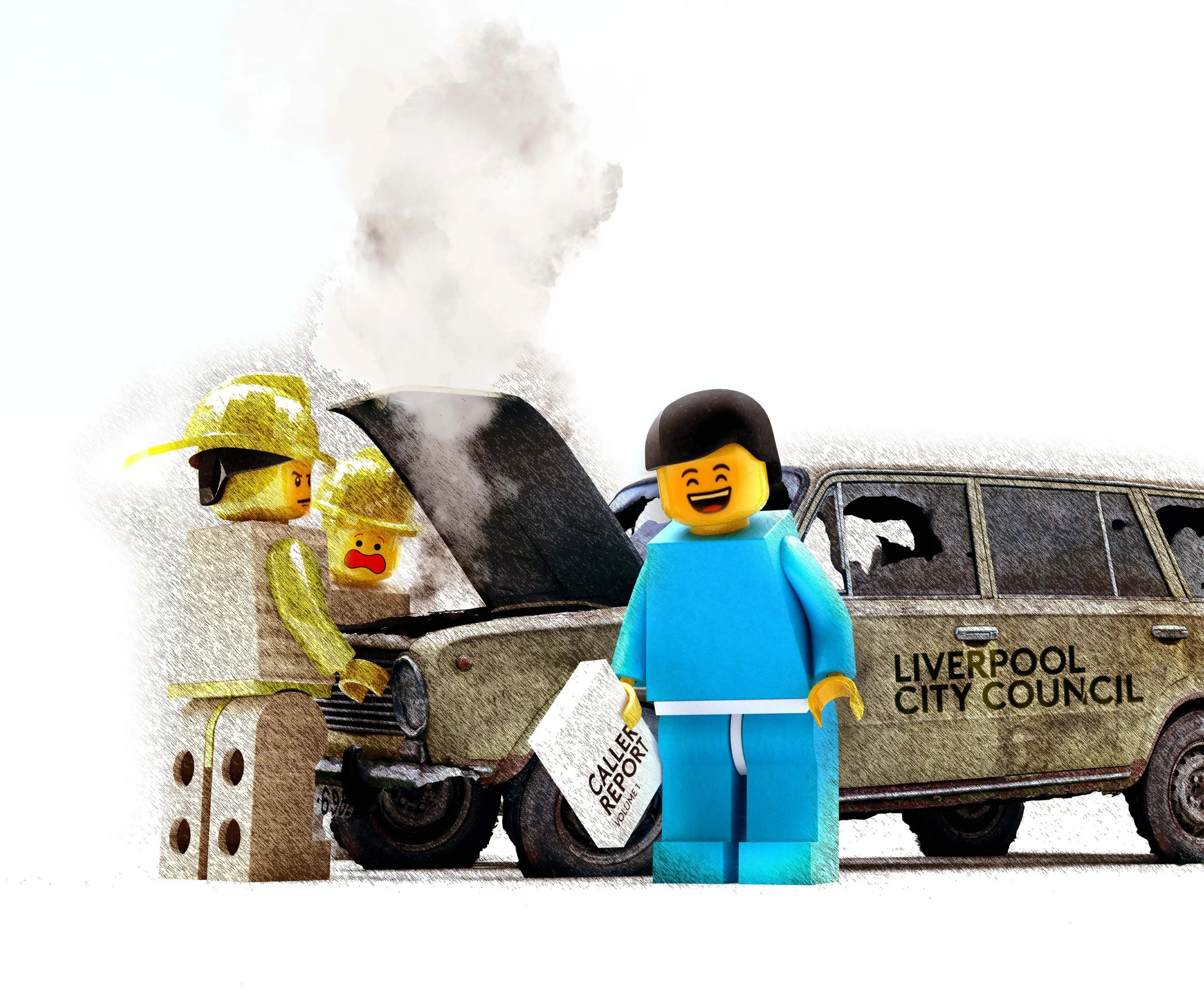Recent features
HS2 Cuts: A Second Chance for Liverpool
As we wave goodbye to any ideas of HS2 reaching the north, a deafening chorus of betrayal is drowning out attempts to assess the project’s worth more rationally. Yet the inconvenient truth is that many in the north have never been convinced of the value of HS2. In this article, Martin Sloman, a director at influential lobby group, 20 Miles More, asks whether the HS2 re-set is a golden opportunity for Liverpool - a second chance at creating new transport infrastructure that works for our city?
Martin Sloman
As we wave goodbye (at least for now) to any ideas of HS2 reaching the north, a deafening chorus of betrayal is drowning out attempts to assess the project’s worth more rationally. Yet for all that, there is an inconvenient truth displayed every time a BBC journalist puts a microphone in front of the general public - the existence of a clear disconnect between the project’s advocates and your average paying train passenger. Lord Adonis may cry foul but many in the north have never been convinced of the value of HS2. In this article, Martin Sloman, a director at influential lobby group, 20 Miles More, considers the matter from Liverpool’s perspective. He asks the question, is the HS2 re-set a golden opportunity - a second chance at creating new transport infrastructure that works for our city?
And so there it is. HS2 beyond Birmingham has gone the way of the Dodo. It is no more. It has ceased to be. It is an ex-railway.
Prime Minister, Rishi Sunak’s much trailed announcement at the Conservative Party Conference to hack back the UK’s largest public transport project represents not just a big throw of the political dice, but a huge scaling back of HS2’s ambitions. Unless you believe a Starmer-led Labour government will revive the scheme (don’t bank on it), the line will no longer extend to Manchester, instead terminating at Birmingham, the place that likes to call itself ‘the second city’. Brum’s claims have been bolstered now. This news is seen almost universally amongst the commentariat as a body blow to the much-vaunted ‘Levelling Up’ strategy, but what does it mean for Liverpool and our city region? Should we see it less as a disaster for the north and more as a second chance to get our city’s transport infrastructure right?
Liverpool came late to the HS2 debate. It was only after the Phase 2 proposal was revealed in January 2013 that we began to realise how the project would affect us. By then, the route was set in stone, and it didn’t look good. The new line was designed as if Liverpool didn’t exist. There would be stations at Manchester Piccadilly and Manchester Airport, a lengthy tunnel into Manchester city centre and a link to the north via Wigan. Liverpool would be lucky to get new, plastic platform seating.
Under the HS2 plan, its high speed trains would run from Liverpool to London but would first need to traverse almost 40 miles of Victorian railways at slower speeds before accessing new, gleaming track south of Crewe. The Liverpool service would be limited to the shorter 200m ‘classic compatible’ trains with half the seats and would run two services per hour with a running time to London of one hour and 34 minutes. Meanwhile, Manchester would receive the gold-plated service - three 400m double-length ‘captive’ trains per hour, speeding to the capital in one hour and 8 minutes – three times Liverpool’s capacity and 28% faster – the end of historic parity in connections to the south.
The lack of high-speed infrastructure to serve Liverpool would prevent the release of capacity on our existing local network, which was supposed to be one of the selling points of HS2. This would severely limit the development of new passenger and freight services and ran contrary to the recommendations of ‘Rebalancing Britain: Policy or Slogan?’ – the Heseltine / Leahy report of 2011 which stated:
‘Government should amend the currently proposed High Speed 2 route, so it connects to both Manchester and Liverpool directly. In the same time frame and to the same standard, Government should commit to assuring Liverpool’s historic parity with Manchester for travel time to London and thereby avoid harmful competitive disadvantage to Liverpool in attracting inward investment’.
That harmful competitive disadvantage was confirmed by accounting giants KPMG who produced their report – HS2 Regional Economic Impacts on behalf of HS2 in 2013. It showed maps of Britain covered in big green circles, where HS2 would uplift the economy of cities and towns. There were, however, little red circles and they were less good news and one of them was over Liverpool. To be fair, the report claimed Liverpool’s GDP could be uplifted by 1.2% in ‘favourable’ conditions, but equally it could shrink by 0.5% in ‘unfavourable’ ones. Not exactly a ringing endorsement and a worse outcome than for towns and cities that were not even connected to the network in any way, such as Hull.
In response to this threat, a coalition of academics and local business figures led by Andrew Morris banded together to form 20 Miles More, an independent campaign group lobbying for a direct, dedicated link to HS2. The 20 miles referenced in the name referred to the length of the shortest link to the HS2 network. Our group, of which I was a director, produced reports, met with political, business and transport leaders and responded to consultations. The assistance of political consultants Jon Egan and Phillip Blond helped us to secure television coverage for our launch event.
Something must have stirred because not long after the Liverpool City Region Combined Authority and the local councils woke up to the danger and launched their own campaign called Linking Liverpool and we’d like to think we had something to do with that. They calculated that a direct Liverpool link to HS2 would be worth £15 billion to the local economy and secure 20,000 new jobs. At last, the issue facing our city was being taken seriously.
“That harmful competitive disadvantage was confirmed by accounting giants KPMG. Their report showed maps of Britain covered in big green circles, where HS2 would uplift the economy of cities and towns. There were, however, little red circles and they were less good news and one of them was over Liverpool.”
One point that we made in our report was that a Liverpool link to HS2 could form part of a new rail link to Manchester and over the Pennines to Leeds. We felt vindicated when the Northern Powerhouse Rail initiative was launched in 2014. This envisaged six northern cities – Liverpool, Manchester, Leeds, Hull, Sheffield and Newcastle being linked by new high speed rail infrastructure. This resonated with Boris Johnson’s ‘Levelling up’ agenda.
In 2020, construction work on the first phase of HS2 (London to Birmingham) started and the realities began to strike home. The prospect of miles of countryside being torn up for a new railway generated local opposition and the wrath of environmental groups, especially in the home counties, but it was the rapidly escalating cost of the project that really concentrated minds. An initial 2010 estimate of £33 billion had now ballooned to £71 billion with some commentators suggesting the final figure could be well over £100 billion.
Why costs spiralled out of control may be down to a number of reasons – overspecification of the initial project, inflation, procurement issues, planning delays, environmental mitigation, and of course, government interference. The result was cutbacks and delays, culminating in Rishi Sunak’s announcement at the Tory’s Manchester Conference – bad news for ‘the north’ delivered in the self-declared heart of ‘the north’, eyeball to eyeball.
Figure 1
Routes and phasing of HS2 as they stand following Sunak’s recent announcement.
Looking at the map, what Sunak has done is to prune HS2 back to Phase 1, which runs from London to Birmingham. Gone is Phase 2a from Birmingham to Crewe, Phase 2b (East) from Birmingham to East Midlands Parkway and Phase 2b (West) from Crewe to Manchester. What has been retained is the link from London Euston to Old Oak Common (reportedly now subject to finding private sector investment) – vital for delivering an effective HS2 service – as well as the link at Lichfield (Handsacre) junction to the existing West Coast Main Line, which allows trains from Liverpool and Manchester to make use of HS2.
The implications for the North West are significant and on the upside, the damaging inequality between Liverpool and Manchester identified by Heseltine and Leahy has been removed. So, from the completion of Phase One (currently scheduled for some time between 2029 and 2033), both Liverpool and Manchester will have services to London making use of existing tracks as far as Lichfield. Trains will run on HS2 for over 60% of the distance from London to the North West with the remainder of the journey on the much slower classic network. That will give a journey time to Liverpool of around one hour and 46 minutes and to Manchester of one hour and 41 minutes. This five-minute difference contrasts with the 26-minute difference that would have occurred had Phase 2b gone ahead. Liverpool’s train capacity will be unaffected, remaining at two 200m long units per hour (each carrying up to 550 passengers) - whereas Manchester will see a halving of its promised capacity to three 200m units. This is because the 400m long, 1100 passenger ‘captive’ trains (trains that can only run on the new HS2 route) that were to serve Manchester under the original plans can no longer do so.
“It is difficult to support a proposal that would deliver so little to our city and so much to a city that is an economic rival.”
The reduction in overall train capacity and increase in journey time is, of course, a body blow to the North West and has resulted in accusations of betrayal in certain quarters. But while the avoidance of baked-in disadvantage between our two cities might provoke a sigh of relief in some, it would be wrong to assume that what is bad for Manchester must be good for Liverpool. As Jon Egan pointed out in his recent Liverpolitan article, Mancpool: One Mayor, One Authority, One Vision, the real disparity is not so much between Liverpool and Manchester but between the two cities and London. However, it is difficult to support a proposal that would deliver so little to our city and so much to a city that is an economic rival.
Rethinking Northern Powerhouse Rail
Another victim of the latest cuts is Northern Powerhouse Rail. This body is to be replaced by a new entity known as Network North and improved journey times are promised from Manchester to Bradford, Sheffield and Hull with £12 billion allocated to a link between Manchester and Liverpool. How that money is to be spent will be the subject of agreement between our civic leaders (and presumably other North West towns such as Warrington).
Northern Powerhouse Rail envisaged high speed lines linking the main cities of the North West. However, when the Department of Transport published the Integrated Rail Plan (IRP) in 2021, these aspirations were somewhat diluted.
Figure 2:
The Integrated Rail Plan (2021) - not so integrated now
“What does all this mean for that ring-fenced £12bn route between Liverpool and Manchester? Will there still be a requirement for the Manchester Airport tunnel? Budgeted around the £5bn mark (before inflation hit) that would take a hefty chunk out of the available cash.”
According to the IRP plan, the Liverpool to Manchester rail route would be achieved by a mixture of upgraded freight and passenger lines, some new construction and the Manchester branch of HS2.
This arrangement was never optimum – being seen as a ‘bolt-on extra’ to HS2. However, it did directly connect Liverpool to the new rail network allowing a London connection to HS2 via Tatton Junction.
Changes were made to the IRP routing following the publication of Sir Peter Hendy’s Union Connectivity Review in November 2021. Hendy identified that the best way of increasing passenger and freight capacity to Scotland and Northern Ireland (via the Port of Liverpool) was by upgrading the existing West Coast Main Line north of Crewe.
The proposed route of HS2 to the North – the ‘Golborne Spur’ to the east of Warrington - was subsequently deleted and a review put in place to determine an alternative route that better met the aspirations of the Hendy report. This is, for now, clearly off the agenda.
So, what does all this mean for that ring-fenced £12bn route between our cities? Will it stay the same or once again morph into something else? Certainly, this is an opportunity to completely rethink the Liverpool to Manchester link. For example, will there still be a requirement for the Manchester Airport tunnel? If so, budgeted around the £5bn mark (before inflation hit) that would take a hefty chunk out of the available cash – although it is difficult to see how else a new link can be run into central Manchester. However, given that there is no longer a need to accommodate HS2, strictly speaking there’s no reason why an improved alignment can’t be sought. But there may be other ways to spend the money.
A Mersey Crossrail?
Prime Minister Sunak has promised that the £36 billion ‘saved’ by the cancellation of HS2 Phase 2 will be re-invested in a plethora of new transport projects. Mention has been made of electrifying the North Wales main line, extending the Midland Metro, a host of road projects and finally giving Leeds its long-promised metro. Given that the cancellation means that we in Liverpool will now suffer from reduced journey time to the capital, let’s hope that a reasonable slice of that money comes to our city.
Liverpool has a developed transport network thanks to the infrastructure work of the 1970s, which gave us the Merseyrail system. However, one problem with the network is its limited coverage. The frequent electric trains running underground in the city centre only serve the Wirral, Sefton, a narrow strip of north, south and central Liverpool (but not the east) and a small part of Knowsley. That is a result of a failure to complete the original project following funding constraints in the mid-70s.
Now, we have the chance to complete that project – something that would give the Liverpool City Region a comprehensive rapid transit system second to none in the UK outside the capital.
I’m going to call it Mersey Crossrail because it would truly open up transit from north to south and east to west. It would make possible near seamless travel not only within Liverpool but also to the important network of satellite towns around and beyond the city region. The access to new job and lifestyle opportunities that would arise would be transformative for our people, while also encouraging modal shift to greener forms of transport. How much would this work cost? Probably in the region of £1 billion, which is a fraction of the cost of constructing a similar system in another city. That is because so much of the system is already in place.
So, what would this project entail? Apologies in advance because I’m now going to get into the nuts and bolts. I can’t help myself, I’m a rail enthusiast.
“Mersey Crossrail would make possible near seamless travel not only within Liverpool but also to the important network of satellite towns around and beyond the city region.”
Imagined, new Liverpool Central Station at the heart of an expanded Merseyrail network. Images by: mmcdstudio.
A 4-Step Transport Plan for Liverpool - Features and Benefits
Step 1. Expand Liverpool Central Station
First up, an expansion of Liverpool Central station, which currently hosts Northern Line services to Southport, Ormskirk, Kirkby and Hunts Cross. The station suffers from overcrowding due to its cramped island platform and the need for enlargement has long been recognised.. Widening the station envelope would not only improve the passenger experience, it would also unlock the next stage of transport expansion.
Step 2. Unlock the network by building the ‘Edge Hill Spur’
A new tunnel would be constructed from the south end of the station to Edge Hill connecting to the disused Wapping Tunnel which dates from the opening of the Liverpool and Manchester Railway in 1830. This proposal was formerly known as ‘The Edge Hill Spur’ and is the key to unlocking the true potential of the Merseyrail network because trains would now be able to run seamlessly east to west underneath the city streets in part by using old, mothballed underground tunnels. This Edge Hill link would effectively form a Mersey Crossrail with the prospect of services running between towns such as St Helens and West Kirby. Construction would involve minimal disruption to existing services thanks to header tunnels constructed back in the ‘70s.
The benefits of such a scheme are immense. Merseyrail would be cheaper to run because transiting through the city instead of terminating makes more economical use of trains and train crews, potentially increasing train frequency. However, it’s the expanded travel opportunities that would be the major plus.
Every station on Merseyrail would be within a maximum of one change of every other one. For example, City Line passengers would have direct access to Liverpool Central and Moorfields with their retail and employment opportunities or could run through to other destinations such as Birkenhead, Chester, Bootle or Southport.
“Every station on Merseyrail would be within a maximum of one change of every other one.”
Step 3. A new underground station for the Knowledge Quarter
One proposal that’s never made it off the drawing board is an underground station near to the university on Catherine Street serving the Hope / Myrtle Street area. Build the Mersey Crossrail and this could become a realistic option, not only adding important services for our legion of students and academics but also a much-needed shot in the arm for the broader Knowledge Quarter, including the strategically important Paddington Village area with its growing medical biotech cluster.
Step 4. Create new Merseyrail branches to the wider city region and beyond
With the partial reconstruction of a former flyover at Edge Hill, City Line services could link Runcorn to St Helens and Newton-le-Willows. This would add three more branches to the Merseyrail network covering a broader sweep of Liverpool, Knowsley, St Helens and Halton. Services could even be extended beyond the City Region boundary to Wigan, Manchester and Crewe thanks to the Northern Hub electrification schemes of the last decade and the introduction of the new fleet of Merseyrail trains with their dual voltage capability.
Another opportunity, which is already in progress, and which would benefit from additional funding, is the extension of the existing Merseyrail network using battery technology. We can now see this technology in operation with the opening of the new Kirkby Headbolt Lane station. This is served by trains running off the electrified network from the existing terminus at Kirkby. Future proposed destinations include Preston via Ormskirk, Warrington Bank Quay via Helsby, Wigan Walgate via Kirkby and, possibly the complete length of the ‘Borderlands’ Line from Bidston as far as Wrexham.
One great benefit of battery extensions, apart from avoiding the cost of extending electrification, is the opportunity to displace existing diesel services (e.g. Kirkby to Wigan, Ormskirk to Preston), so both reducing operating costs and harmful emissions.
Figure 3:
Shows the Merseyrail extensions possible with the Mersey Crossrail scheme. It also shows the existing proposals for battery extensions of the existing Wirral and Northern Lines.
With all of the proposed extensions in place, Merseyrail would become a powerful regional rail network, fully integrated into Liverpool City Centre. It would extend both into North East Wales and Greater Manchester.
It should be noted that, these extensions reflect the level of spending on transport expected for a city region the size of Liverpool, with a population of 1.5 million people. It is by no means extravagant.
The cancellation of Phase 2 of HS2 has been a blow for the North West region. However, the Liverpool City Region missed out on the initial proposals. Now, there is an excellent chance to redraw the rail map of the North West to give a more equitable distribution of the benefits that will still flow from the Phase 1 railway.
We now have a second chance with everything to play for. So, let’s hope that our political leaders take notice and deliver us the transport system that the region so clearly requires.
Martin Sloman is a civil engineer and former railway consultant. He is a director of the ‘20 Miles More’ lobby group, a coalition of academics and local business figures, which campaigned for a direct link from Liverpool to HS2.
What do you think? Let us know.
Add a comment below, join the debate via Twitter or Facebook or drop us a line at team@liverpolitan.co.uk
Don’t knock it till you’ve tried it!
Following the announcement that UNESCO had stripped Liverpool of its World Heritage Status, there have been a myriad of social media posts and articles about what this means (or doesn’t mean) for the City. Some expressed mild disappointment and some adopted a more ‘we’ll be fine without it’ approach.
Lynn Haime
Following the announcement in July that UNESCO have stripped Liverpool of its World Heritage Status, there have been a myriad of social media posts and articles about what this means (or doesn’t mean) for the City. Some expressed mild disappointment and some adopted a more ‘we’ll be fine without it’ approach.
It did, however, make me pause to consider my city - its charms, shortcomings, history and future and ultimately conclude that, once again, the external perception of Liverpool will have unfairly taken a knock.
Having lived, studied or worked in the South, Birmingham and Manchester over the past 20 or so years it reminded me that, unlike any other city, we regularly have to defend our position and correct misinformed views of Liverpool. I have penned this article for colleagues, friends and family who have either never visited the city, or have not revisited it for years. Some of the views of those who are unfamiliar with Liverpool are exacerbated by the consistent and inaccurate stereotypes from the ill-informed. Hangovers from days of rioting and overtly vocal politicians dominating our screens in the 80s, to the more light hearted, tracksuit-donning, curly wig-wearing characters portrayed on television – admittedly very funny at the time, but over 30 years later, they are just an irritating perpetuation of an image which couldn’t be further from today’s Liverpool.
In 2008, Liverpool was European Capital of Culture which catapulted the city to another, much more positive level of exposure. The significant impact of that is still felt today - on cultural initiatives, regeneration, visitor numbers and economic growth. Clearly all is not yet perfect and we sighed in collective exasperation at the recent exposure of questionable practices from certain high-level public servants. It was a setback caused by a very small minority which unfortunately reinforced some of those outdated stereotypes. The majority of us work hard to promote the city, encourage investment and enhance the already exciting opportunities which exist. But this was a disappointing blow. However, it is being addressed admirably by Tony Reeves, the current Chief Executive of Liverpool City Council. He has helped to expose the previous, less scrupulous practices and promote a more transparent and trustworthy platform on which to build.
…we regularly have to defend our position and correct misinformed views of Liverpool.
One of the key concerns cited by UNESCO was the development of Everton’s new 52,000-capacity stadium on the waterfront. Its official address is Bramley-Moore Dock, which Wikipedia describes as ‘a semi-derelict dock on the River Mersey’. It’s a stone’s throw away from Bootle which remains one of the most deprived areas in the UK. Everton FC have jumped through planning and heritage hoops and will be investing over £500m in developing their new stadium, which will deliver an estimated £1.3bn boost to the local economy, create more than 15,000 jobs and attract 1.4m new visitors to the city.
The project budget includes £55m for ‘preserving, restoring and celebrating the heritage assets’ and is located in an unloved part of town and what was the ‘buffer zone’ of the World Heritage designation. The main UNESCO site was focused elsewhere, around the majestic Three Graces (The Grade 1 listed Royal Liver Building, Port of Liverpool and Cunard buildings). Regardless of UNESCOs decision, all three remain standing proud and unaffected, overlooking the Mersey and adjacent to the magnificent Royal Albert Dock.
The area connecting Everton’s new stadium to that world famous waterfront is largely under the ownership of Peel Land & Property and their £5.5bn Liverpool Waters project. Should that scheme ever go-ahead, it will bring further regeneration and investment to entirely new communities along the waterfront, providing a vital link between the city centre, the northern fringe and the new stadium.
Everton FC have jumped through planning and heritage hoops and will be investing over £500m in developing their new stadium…
Also in the mix is the Stanley Dock and Ten Streets Regeneration area including the Titanic Hotel, one of Liverpool’s most popular stay-overs and the Grade II Listed Tobacco Warehouse, Europe’s largest brick building and soon to be home to 538 apartments and 100,000 sq ft of new commercial space. My own view, echoing many others, is that whilst UNESCO endorsement was nice to have, this investment and regeneration will be far more wide-reaching, directly beneficial for the city and a real catalyst for future growth. I would encourage anyone who hasn’t visited Liverpool to come and see it for themselves. I’ve found over the years that those with negative views of the city are those least familiar with it. It seems this can also be said of UNESCO who made their decision without setting foot here in over 10 years.
A future Liverpool skyline after UNESCO?
The overwhelming majority of comments on the removal of World Heritage Status expanded on the many virtues of Liverpool, far more eloquently than I could. The culture, history, architecture, the magnificent cathedrals, the waterfront, two world-class football clubs, successful universities, its extensive talent pool, world leading science institutions, incredible nightlife, and the amazing people. Of course, no commentary on Liverpool would be complete without mention of the four sons of the city. The most successful group of all time and famous the world over, The Beatles still generate around £20m per year for Liverpool through tourism. The removal of our World Heritage badge will not deter the streams of overseas visitors hopping on to the Magical Mystery bus to Penny Lane, Strawberry Fields, The Cavern, and the birthplaces of John and Paul. As one of my southern colleagues mentioned, Abbey Road… I pointed out that this was in London and rested my case.
Lynn Haime is a Partner at commercial property consultancy, Matthews and Goodman. She heads up their Liverpool office.
Share this article
What price heritage?
The UNESCO World Heritage Committee meets in China this July. One of the items on the agenda is going to be the recommendation to delete Liverpool – Maritime Mercantile City from the list of World Heritage Sites. If Liverpool is deleted from the list, it will be the only UK site ever to suffer this fate and only the second in Europe. There can be no doubt that the decision will be something that the city can do without at a time when it is struggling to emerge from the Covid pandemic and will, no doubt, attract far more attention in the national media than the original listing ever did. So, how have we got into this situation?
Martin Sloman
The UNESCO World Heritage Committee meets in China this July. One of the items on the agenda is going to be the recommendation to delete Liverpool – Maritime Mercantile City from the list of World Heritage Sites.
If Liverpool is deleted from the list, it will be the first UK site ever to suffer this fate and only the second in Europe. It’s a decision the city can could do without at a time when it’s struggling to emerge from the Covid pandemic. No doubt, the decision will attract far more attention in the national media than the original listing ever did. So, how have we got into this situation?
One thing is clear, UNESCO has a point. The inscription of the Liverpool site arose from an agreement to protect the Outstanding Universal Value (OUV) of the property. The development of Liverpool Waters was pursued outside of any planning framework agreed with UNESCO despite their repeated requests. The decision to develop a major football stadium on Bramley Moore Dock has brought matters to a head.
There is a wider issue though and that’s the value of World Heritage Status to a city such as Liverpool, which is always struggling to attract investment and jobs.
There are thirty-two WHS sites in the UK. Nearest to Liverpool are the Castles of Gwynedd, North Wales including those of Conwy, Caernarfon and Beaumaris, which boast some of the finest examples of medieval military defences in Europe. Even though their military function is long gone, it makes complete sense to preserve these buildings and their setting. Today they earn their keep through their popularity with tourists.
Further afield, the City of Bath is a WHS more comparable to Liverpool. The value of Bath lies in its ability to evoke, through its townscape and architecture, the Georgian and Regency eras immortalised in the novels of its most famous resident, Jane Austen. However, unlike the Gwynedd castles, Bath’s famous buildings are still in use, as residences, offices and hotels. Whilst modern Bath may not be as fashionable as in Jane’s day, it remains a relatively prosperous city.
The lesson for Liverpool is surely that heritage and modern usage need to exist side by side. Derelict docks and warehouses do not have the tourist draw of ruined castles; so we need to reimagine these places for the 21st century. Despite all the gloom surrounding World Heritage Status, we must not forget that Liverpool has been quite successful in doing just that.
The Albert Dock – abandoned and derelict in the 1980s - is now one of the country’s major heritage attractions. The combination of museums, shops, bars and restaurants, offices, hotels and private apartments has worked. Purists may not like the cast iron columns painted red but little of heritage value has been lost.
The lesson for Liverpool is surely that heritage and modern usage need to exist side by side.
Much the same can be said of Stanley Dock. Preserving the gargantuan Tobacco Warehouse was once seen as a hopeless task but the conversion of the building into apartments is now well underway.
Of course, not all our heritage docks are graced by giant warehouses, but Brunswick and Coburg docks now host a marina, Queens Dock has a water sports centre and Salthouse Dock is a haven for canal narrow boats. So new uses can be found for old docks but what is questionable is the heritage value of these new uses.
There’s a classic heritage dilemma surrounding the future use of the Cavendish Cutting, which is just off Tunnel Road in Edge Hill. This, largely forgotten cutting was the scene of the official opening of the Liverpool and Manchester Railway and the departure point for the first ever trains from Liverpool to Manchester. As such, it is one of the most important relics of the railway age and, deserving of World Heritage status. People have campaigned for its recognition by UNESCO as an extension to the existing World Heritage Site.
One problem lies in the fact that Merseyrail has a long-term proposal to run a passenger rail service through the Wapping Tunnel, which opens into the cutting. The proposal would integrate the City Region’s rail network and vastly improve public transport provision. However, re-opening the cutting to rail services would detract from the Outstanding Universal Value of the site. Or, in other words, re-using a heritage asset for its original purpose removes its heritage value. What would the great British civil engineer and ‘Father of Railways’ George Stephenson have thought?
It can, of course, be argued that any form of development – even remodelling docks for modern shipping – adversely affects the Outstanding Universal Value of a site. If we are to prioritise heritage over modern needs the logical but obsurd conclusion would be to leave the heritage asset in its derelict state and forbid any development. That works for Conwy Castle – but would it work for the vast areas of prime real estate represented by Liverpool’s heritage docks? Even Historic England accepts that this area needs regeneration. However, given the absence of historic warehouses, such as at Stanley and Albert Docks, what is it exactly that they expect?
Historically, Liverpool’s dockside buildings have varied in scale from single storey transit sheds to the Stanley and Waterloo Dock warehouses and the long gone but imposing Clarence Dock Power Station. Consequently, there can be no definitive template for future development of the area.
One cue might be taken from the docks themselves – often hundreds of metres in length. Would they be dwarfed by even a 200m high tower?
The debate between the heritage and development lobbies has become very polarized but, if there is one area of agreement it’s surely that whatever is built within the World Heritage Site should be of outstanding architectural quality. However, if we’re realistic, quality of design and materials cannot be divorced from the financial return that the developer requires to make a project viable, which will be more difficult to achieve where the scale of development is constrained.
Obtaining agreement on what is ‘appropriate’ development on a site such as Central Docks is not an easy process. It involves input from different interests and requires an ability to compromise on all sides.
We have been led to believe that the final nail in the coffin of the World Heritage Site has been the decision to grant planning permission for Everton’s stadium on Bramley Moore Dock. Bramley Moore is the northernmost and largest of the docks within the WHS and forms part of a complex of five docks that were state of the art when opened in the 1840s. It is only natural that UNESCO would take a dim view about its infilling.
Yet there are other considerations. Bramley Moore is outside of the World Heritage Site- in the ‘buffer zone’. It screens the WHS from a large wastewater treatment plant on its northern side. The Everton plan is not a bog-standard football stadium but consists of an elegant, curved roof topping a brick sub-structure designed to emulate traditional dock-side warehouses. The original dock walls are to be preserved and a channel retaining the link with the Northern Docks is to be retained. The existing hydraulic tower will be refurbished and incorporated into the stadium setting. Everton describe this scheme as a ‘heritage project’ and that is hard to deny.
In fact, Bramley Moore stadium could be said to define the northern limit of the Central Docks in much the same way as the Three Graces indicate their southern limit. As has been often pointed out, the Three Graces were themselves built on an infilled dock.
So, is Bramley Moore dock the deal-breaker? Are UNESCO unable to compromise to allow such an important regeneration project? After all, one of Britain’s most famous World Heritage Sites, the Tower of London does not seem too bothered by ‘buffer zones’.
Buffer Zones in action: The Chapel of St Peter ad Vincula at the Tower of London WHS – burial place of Henry VIII’s wives – yet overshadowed by the infamous ‘Walkie Talkie’.
Maybe if Liverpool – Maritime Mercantile City is to have a future, it will depend on constructive dialogue between heritage bodies, developers and Liverpool City Council.






































